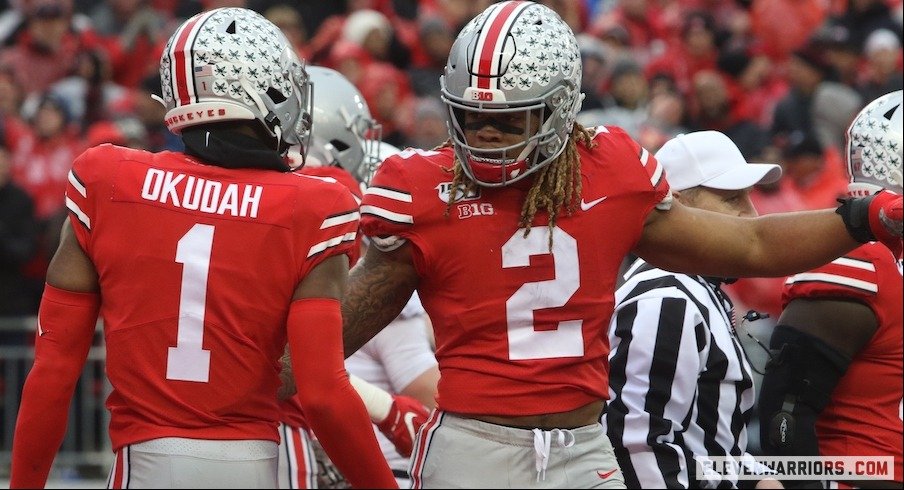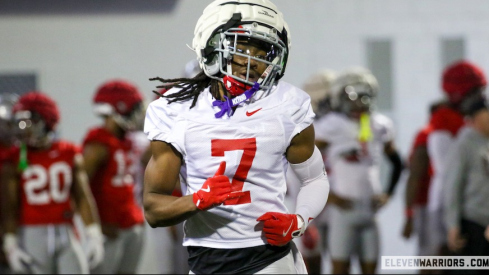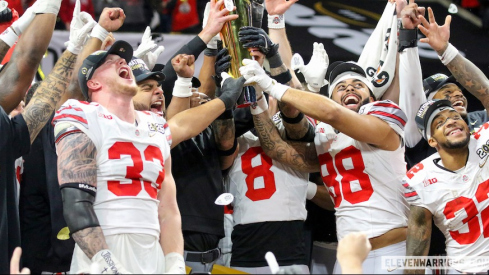Ohio State’s class of 2017 arrived in Columbus with the highest average composite player rating of any recruiting class in school history. It lived up to the hype.
No, the class didn’t achieve the ultimate goal of winning a national championship. But the class, whose members contributed to four straight Big Ten championships, three College Football Playoff berths and one national championship game appearance, ended up being one of the most star-studded recruiting classes in Ohio State history just as it was supposed to be.
A full third of the class’ 21 signees went on to become first-team All-Americans. Just under half of them (10) were selected in the NFL draft. More than two-thirds of the class’ members became significant contributors for the Buckeyes for at least one season.
The class’ five-star prospects like Chase Young, Jeff Okudah and Wyatt Davis became the Ohio State stars they were supposed to be, while less heralded recruits like Pete Werner and Thayer Munford went on to have highly productive careers, too. In a class where Ohio State emphasized quality over quantity, that rang true as only a handful of players in the class never became meaningful contributors for the Buckeyes.
Jerron Cage was the final member of Ohio State’s 2017 class to play for the Buckeyes, finishing his career with the Buckeyes last season before going through the NFL draft process last weekend and signing with the New Orleans Saints as an undrafted free agent, becoming the 15th member of the class to spend time with an NFL team.
With the 2017 class’ time at Ohio State now officially complete, it’s time for a final look at how that class of Buckeyes fared in Columbus and why it should be remembered as one of the Buckeyes’ most productive recruiting classes ever.
Seven All-Americans
As aforementioned, seven different members of Ohio State’s 2017 class went on to be considered the best player in college football – or one of the few best at positions where multiple first-team All-Americans are named – by at least one major organization in at least one of their seasons at Ohio State.
That started with the class’ two highest-ranked recruits, No. 7 overall prospect Chase Young and No. 8 overall prospect Jeff Okudah, who both earned unanimous first-team All-American honors while leading Ohio State’s 2019 defense, which led the nation with only 259.7 yards allowed per game.
Young became the first-ever defensive player from Ohio State to be named a Heisman Trophy finalist amid one of the most dominant seasons ever for a collegiate defensive end as he recorded 21 tackles for loss with a school-record 16.5 sacks and six forced fumbles. Okudah established himself as the nation’s top lockdown cornerback while recording three interceptions, nine pass breakups and two forced fumbles in his lone season as a full-time starter for the Buckeyes.
Wyatt Davis and J.K. Dobbins also both earned first-team All-American honors in 2019, when Davis established himself as one of college football’s best interior offensive linemen while Dobbins ran for a school-record 2,003 yards. One year later, Davis would become the third unanimous All-American from the 2017 class when he earned those honors for the 2020 season. As a result of his back-to-back All-American campaigns, Davis was later named to Big Ten Network’s All-Decade team of the 2010s (as Young also was).
Shaun Wade also earned consensus All-American status in 2020 (though many Ohio State fans would agree his best season as a Buckeye came in 2019, when he played slot cornerback before moving to outside cornerback in 2020), as did Haskell Garrett, who delivered one of the most inspirational stories in college football as he became one of the nation’s most disruptive defensive linemen despite being shot in the face while attempting to break up a domestic dispute that August.
Thayer Munford became the seventh member of the class to earn first-team All-American honors in 2021 – though, again, there’s an argument he was better in previous years as a left tackle than he was after moving to left guard in 2021 – when he was named an All-American by the American Football Coaches Association.
Nine total members of the 2017 class earned first-team All-Big Ten honors. Young, Okudah and Dobbins were all first-team All-Big Ten honorees in 2019. Davis, Munford and Josh Myers all earned first-team All-Big Ten honors on the offensive line while Wade and Pete Werner earned All-Big Ten honors on defense in 2020. Garrett and Munford were both All-Big Ten first-teamers in 2021.
Blake Haubeil was a third-team All-Big Ten selection in 2019 while Baron Browning was a third-team All-Big Ten honoree in 2020. Kendall Sheffield was an All-Big Ten honorable mention in 2018 while Marcus Williamson was an All-Big Ten honorable mention in 2020.
10 NFL Draft Picks
The highest-ranked prospects in the 2017 class were also its highest NFL draft picks, as Young was the No. 2 overall pick (Washington Commanders) and Okudah was the No. 3 overall pick (Detroit Lions) in the 2020 NFL draft, becoming just the second pair of Buckeyes (along with Orlando Pace and Shawn Springs in 1997) to be selected within the top three selections of the same NFL draft.
No other members of the 2017 class became first-round picks, but three became second-round picks: Dobbins (55th pick, Baltimore Ravens, 2019), Werner (60th, New Orleans Saints, 2020) and Myers (62nd, Green Bay Packers, 2020).
Davis (86th, Minnesota Vikings) and Browning (105th, Denver Broncos) were both third-round picks in 2021. Sheffield, the first member of the 2017 class to become draft-eligible as he joined the Buckeyes as a junior college transfer, was selected in the fourth round (111th, Atlanta Falcons) in 2019. Wade was a fifth-round pick (160th, Ravens) in 2021 while Munford was a seventh-round pick (238th, Las Vegas Raiders) in 2022.
Six other members of the 2017 class signed with NFL teams as free agents after going undrafted: Garrett (Tennessee Titans), Haubeil (Titans), Isaiah Pryor (Saints), Brendon White (New York Jets), Jerron Cage (Saints) and Trevon Grimes (Philadelphia Eagles). Three of them, however, didn’t finish their college careers as Buckeyes: Pryor finished his college career at Notre Dame, White finished his college career at Rutgers and Grimes finished his at Florida.
While Cage is the only undrafted member of the class currently on an NFL roster (White currently plays for the Indoor Football League’s Massachusetts Pirates), all 10 of the draft picks are still in the league, though four have changed teams. Okudah was traded to the Falcons this offseason, Davis is now with the New York Giants after spending time with three different teams last season, Wade was traded to the New England Patriots before his rookie season and Sheffield is now with the Houston Texans following a brief stint last year with the Dallas Cowboys.
Young was the NFL’s Defensive Rookie of the Year in 2020 while Dobbins, Werner and Myers have also established themselves as starters with the teams that drafted them. Browning is coming off a breakout 2022 season in which he recorded five sacks after moving from the linebacker position he played at Ohio State to edge rusher, while Munford started four games at tackle for the Raiders as a rookie.
Few Non-Contributors
Except for Grimes, all of the players listed above were starters for Ohio State for at least a portion of a season. Amir Riep, who is still looking to resume his college football career after he and former Ohio State teammate Jahsen Wint were acquitted of rape charges earlier this year, also played in 40 games for the Buckeyes as a backup defensive back and special teams contributor before his Ohio State career ended in 2020.
Of the 21 scholarship players Ohio State signed in the 2017 class, there were only four who never saw substantial playing time for the Buckeyes. Three of them were wide receivers – Grimes, Jaylen Harris and Ellijah Gardiner – while the other, Tate Martell, ranks among the more famous Ohio State recruits who never actually played meaningful snaps in Columbus.
Martell played 91 snaps as Ohio State’s backup quarterback in 2018 but left the team in 2019, eventually transferring to Miami and later UNLV but playing sparingly at both schools, after Justin Fields was brought in as Ohio State’s new starting quarterback. Grimes left the Buckeyes midway through his freshman year and transferred to Florida, where he went on to catch 97 passes for 1,444 yards and 14 touchdowns over three seasons. Harris and Gardiner both retired from football in 2021 after battling injuries.
The full list of Ohio State’s 2017 signees, how many games (if any) they started at Ohio State, whether they earned All-American and/or All-Big Ten honors and whether they’ve gone on to play in the NFL can be found in the table below.
| Pos | Player | Ranking | Rating | OSU Starts | All-American? | All-B1G? | NFL? |
|---|---|---|---|---|---|---|---|
| DE | CHASE YOUNG | #7 (#2 WDE) | ★★★★★ | 23 Games | Unanimous | First-Team | No. 2 Overall Pick |
| CB | JEFF OKUDAH | #8 (#1 CB) | ★★★★★ | 15 Games | Unanimous | First-Team | No. 3 Overall Pick |
| LB | BARON BROWNING | #11 (#1 OLB) | ★★★★★ | 7 Games | No | Third-Team | Third-Round Pick |
| CB | SHAUN WADE | #17 (#2 CB) | ★★★★★ | 19 Games | Consensus | First-Team | Fifth-Round Pick |
| G | WYATT DAVIS | #24 (#1 G) | ★★★★★ | 24 Games | Unanimous | First-Team | Third-Round Pick |
| WR | TREVON GRIMES | #41 (#6 WR) | ★★★★ | 0 Games | No | No | Undrafted Free Agent |
| RB | J.K. DOBBINS | #46 (#2 APB) | ★★★★ | 40 Games | First-Team | First-Team | Second-Round Pick |
| C | JOSH MYERS | #53 (#2 G) | ★★★★ | 21 Games | Second-Team | First-Team | Second-Round Pick |
| QB | TATE MARTELL | #56 (#2 DUAL) | ★★★★ | 0 Games | No | No | No |
| S | ISAIAH PRYOR | #63 (#8 S) | ★★★★ | 7 Games | No | No | Undrafted Free Agent |
| DT | HASKELL GARRETT | #68 (#6 DT) | ★★★★ | 14 Games | First-Team | First-Team | Undrafted Free Agent |
| CB | KENDALL SHEFFIELD | #3 JC (#1 CB) | ★★★★ | 17 Games | No | HM | Fourth-Round Pick |
| S | BRENDON WHITE | #126 (#3 ATH) | ★★★★ | 6 Games | No | No | Undrafted Free Agent |
| WR | JAYLEN HARRIS | #177 (#28 WR) | ★★★★ | 0 Games | No | No | No |
| DB | MARCUS WILLIAMSON | #182 (#24 CB) | ★★★★ | 14 Games | No | HM | No |
| DB | AMIR RIEP | #186 (#26 CB) | ★★★★ | 0 Games | No | No | No |
| DT | JERRON CAGE | #235 (#14 DT) | ★★★★ | 5 Games | No | No | Undrafted Free Agent |
| LB | PETE WERNER | #277 (#14 ILB) | ★★★★ | 35 Games | No | First-Team | Second-Round Pick |
| OL | THAYER MUNFORD | #285 (#28 OT) | ★★★★ | 45 Games | First-Team | First-Team | Seventh-Round Pick |
| WR | ELLIJAH GARDINER | #796 (#115 WR) | ★★★ | 0 Games | No | No | No |
| K | BLAKE HAUBEIL | #1339 (#4 K) | ★★★ | 27 Games | No | Third-Team | Undrafted Free Agent |
How Other 2017 Classes Compared
Alabama was the only school that signed a higher-rated recruiting class in 2017 than Ohio State, and its class lived up to the hype, too. Nine of the Crimson Tide’s 29 signees became All-Americans: Najee Harris, Alex Leatherwood, Dylan Moses, Jerry Jeudy, Tua Tagovailoa, Jedrick Wills, Xavier McKinney, DeVonta Smith and Mac Jones. Smith won the Heisman Trophy while Tagovailoa and Jones were both Heisman finalists.
Eight members of Alabama’s 2017 class went on to become first-round draft picks: Tagovailoa, Wills, Henry Ruggs III, Jeudy, Smith, Jones, Leatherwood and Harris. McKinney and Phidarian Mathis were both second-round picks while Brian Robinson was a third-round pick. Members of the 2017 class contributed to two national championships for the Crimson Tide, including their title-game win over Ohio State in 2020.
Georgia’s 2017 class, which was ranked third in the 247Sports team composite rankings, produced just two first-team All-Americans: Offensive tackle Andrew Thomas and cornerback Eric Stokes. It did produce 10 NFL draft picks, including four first-rounders: Thomas and Isaiah Wilson in 2020, Stokes in 2021 and Devonte Wyatt in 2022. Jake Fromm was a fifth-round pick in 2020, Monty Rice was a third-round pick in 2021, Richard LeCounte was a fifth-round pick in 2021, Justin Shaffer was a sixth-round pick in 2022, Robert Beal was a fifth-round pick this year and Ameer Speed (who transferred to Michigan State) was a sixth-round pick this year.
USC’s fourth-ranked 2017 class produced two first-team All-Americans: offensive linemen Andrew Vorhees and Brett Neilon, both of whom earned their recognition as sixth-year seniors this past season. Five members of the class were selected in the NFL draft: First-round picks Austin Jackson and Alijah Vera-Tucker, fourth-round pick Jay Tufele and sixth-round pick Marlon Tuipulotu and Vorhees, who was a seventh-round pick this year.
Michigan’s fifth-ranked 2017 class, which included 30 total signees, did not produce any All-Americans but produced 10 NFL draft picks: first-round picks Kwity Paye and Cesar Ruiz, third-round picks Nico Collins, Ambry Thomas and Benjamin St-Juste (who transferred to Michigan), fourth-round pick James Hudson (who transferred to Cincinnati), fifth-round pick Ben Mason, sixth-round picks Donovan Peoples-Jones and Brad Robbins and seventh-round pick Andrew Stueber.
Outside of Alabama and Ohio State, the most successful 2017 recruiting class was LSU’s, which ranked seventh in 247Sports’ composite rankings. While only one member of that class (Grant Delpit) became a first-team All-American, four of them became first-round picks in 2020 – K’Lavon Chaisson, Patrick Queen, Clyde Edwards-Helaire and reigning NFL Offensive Player of the Year Justin Jefferson, a three-star recruit ranked outside the top 2,000 prospects in the class – after helping lead LSU to the national championship for the 2019 season. Nine other members of that class were also drafted: second-round picks Delpit and Ed Ingram, third-round pick Jacob Phillips, fourth-round picks Saadiq Charles, Neil Farrell and Tyler Shelvin, sixth-round picks Racey McMath and JaCoby Stevens and seventh-round pick Kary Vincent.


